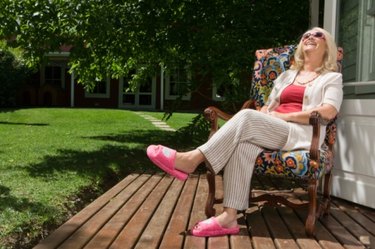
Yellowjackets are the most problematic of all wasps and hornets, largely because of the zeal with which they defend their nests when they feel threatened. These defensive wasps can cause problems when nesting near homes and when they build their colony under a deck it can make enjoying the backyard difficult. Although they can be beneficial and eat other, destructive pests, nests under decks and close to the home should be removed.
Life Cycle
Video of the Day
Yellowjackets usually begin construction on the year's nest in the early spring, so by the time the deck is in regular use it's likely that the yellowjackets have had some time to work on their construction. The queen stays in the nest and the wasps that are commonly seen flying about are the workers. A single nest will continue to expand and can support thousands of yellowjackets if not taken care of as soon as possible. Colonies will reach their peak numbers in August or September, so safely destroying or removing the nests as early as possible--preferably in the spring--can make doing so easier. If left alone until this period, workers will become much more active and new queens will begin leaving the nests. These new queens will be searching for places to spend the winter, which can lead to even more wasps and nests present the following spring.
Video of the Day
Dangers
Yellowjackets are among the most aggressive of wasps. Although they tend to sting only when they feel threatened, a nest in such close proximity to human activity will likely cause conflict.
The worker wasps are those responsible for finding food for the colony, and these insects tend to grow increasingly dangerous as the season progresses and there is a larger colony to support. They are most active during the day, making it likely to come into contact with humans using the deck. These workers are attracted to food, especially sugary sweet items and garbage. While the nest is still present beneath the deck, minimize the chances of stings by keeping foodstuffs away from the deck. They can also be attracted to sweet scents like perfumes, so keep these to a minimum.
Removal
To begin thinning out a summer colony, bait traps can be effective in attracting foraging workers. These workers will then return to the nest with the poisoned bait. Lure traps and water traps, on the other hand, will attract wasps who will become stuck in the trap and unable to return to the nest, dying there instead. These traps can be effective in the fall, when they will lure new queens before they can find a place to stay for the winter.
In the spring when the nest is just forming, apply a pesticide designed specifically for yellowjackets directly to the nest. Wear protective clothing and spray the nest in the evening when they are less active. Repeat until there is no activity seen around the nest then remove using a garbage bag.
When to Call a Professional
If the nest is at an awkward spot beneath the deck--or if you are allergic to stings--it may be prudent to call an exterminator. A pest control company or exterminator can also remove the nests more quickly. If you don't have time to treat and retreat the nest until there are no more visible wasps, calling someone to come in and take care of the problem can be much safer than trying a shortcut. Yellowjackets protecting their nests can swarm to sting the threat, and repeated stings can result in nausea, difficulty breathing and swelling.
There are also some colleges that collect yellowjackets to study the insect and to conduct research on the venom in their sting; contact a local extension office for another avenue to pursue.
- Washington State University Extension: Yellowjackets and Paper Wasps; Peter J. Landolt
- University of California Integrated Pest Management Program: Yellowjackets and Other Social Wasps, 2011
- University of Kentucky Department of Entomology: Controlling Wasps, Hornets and Yellowjackets; Michael F. Potter, 1994
- Oregon State University Extension: Know thy enemy—a primer on yellow jackets; Carol Savonen